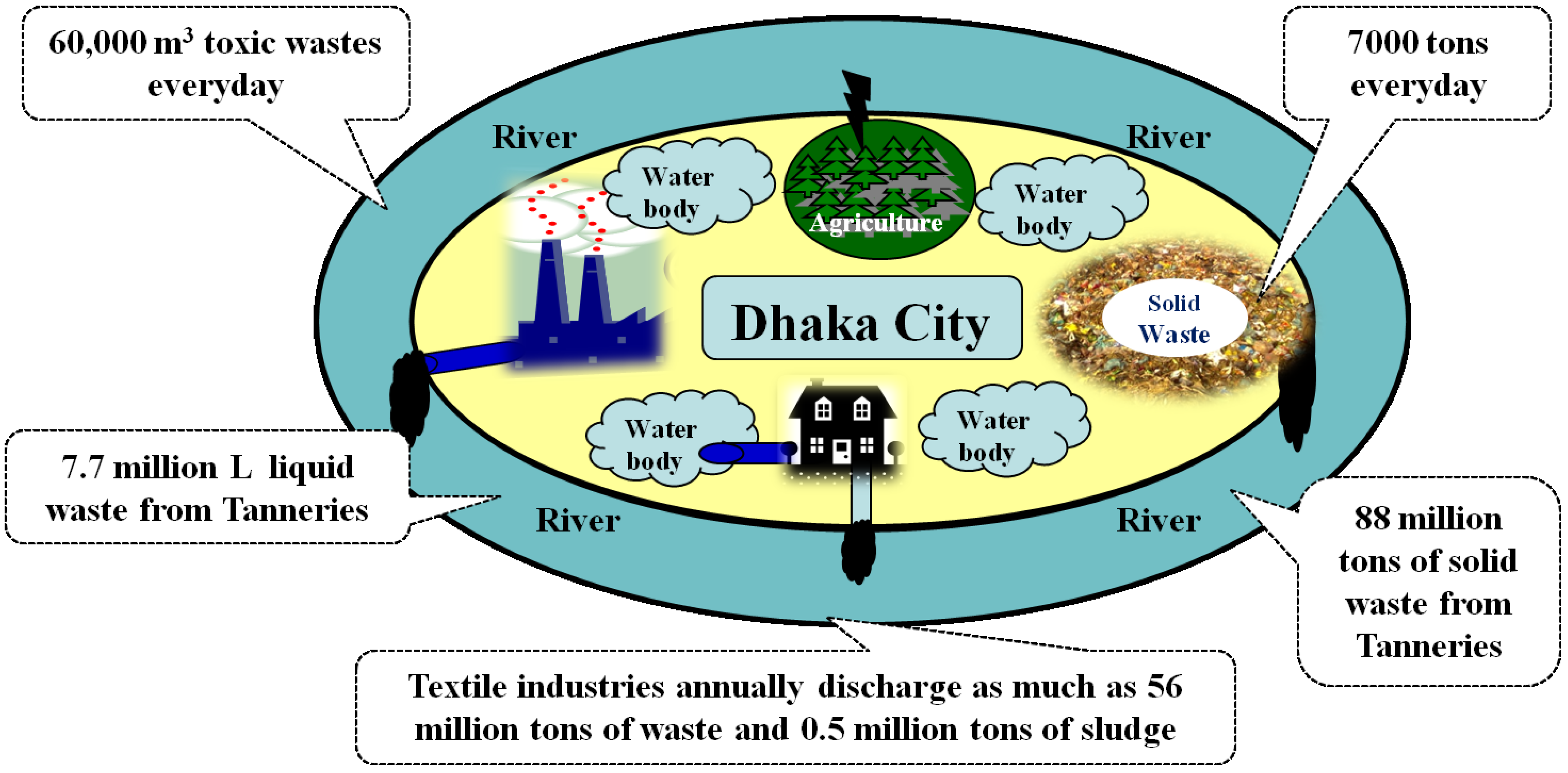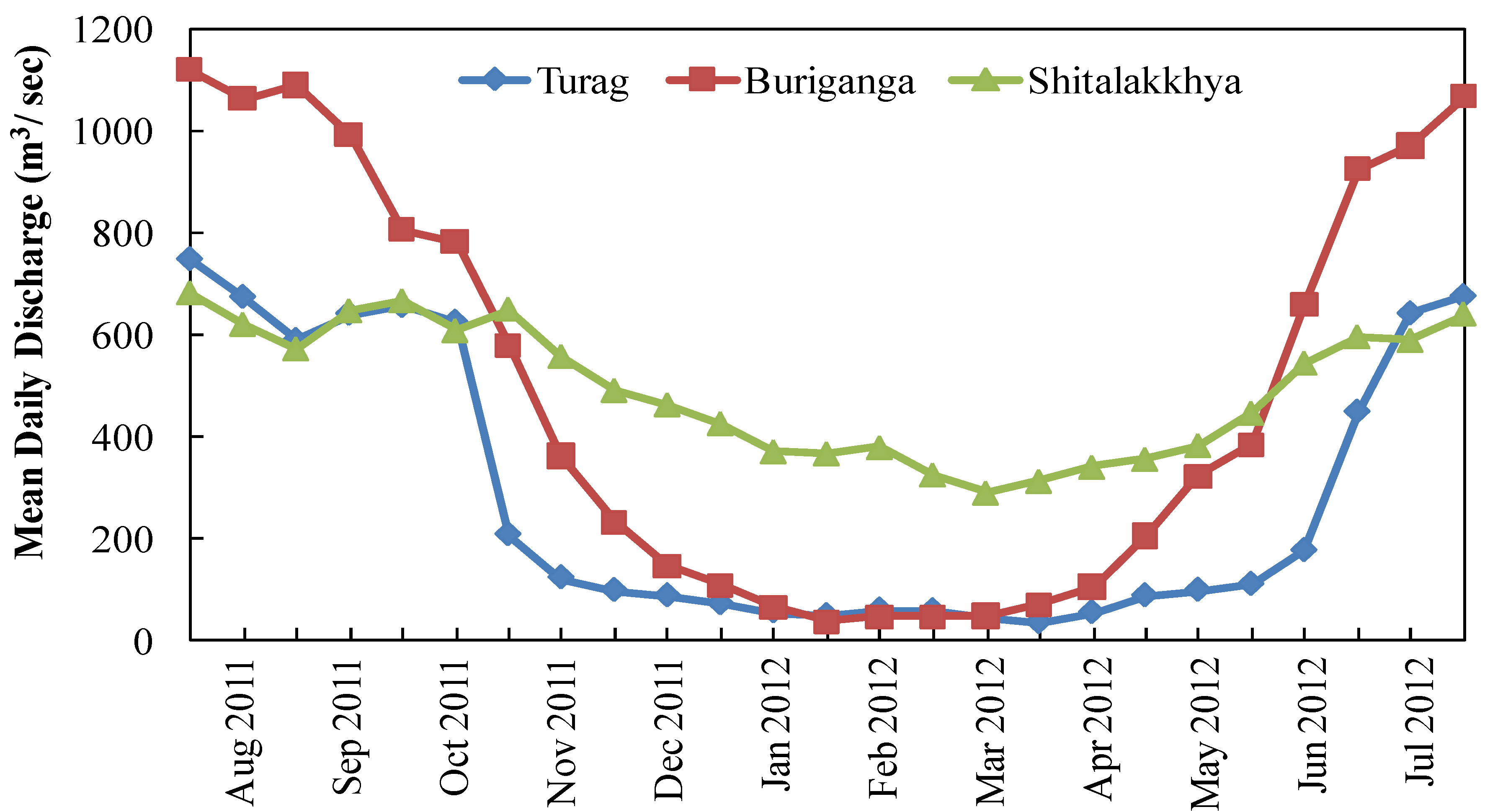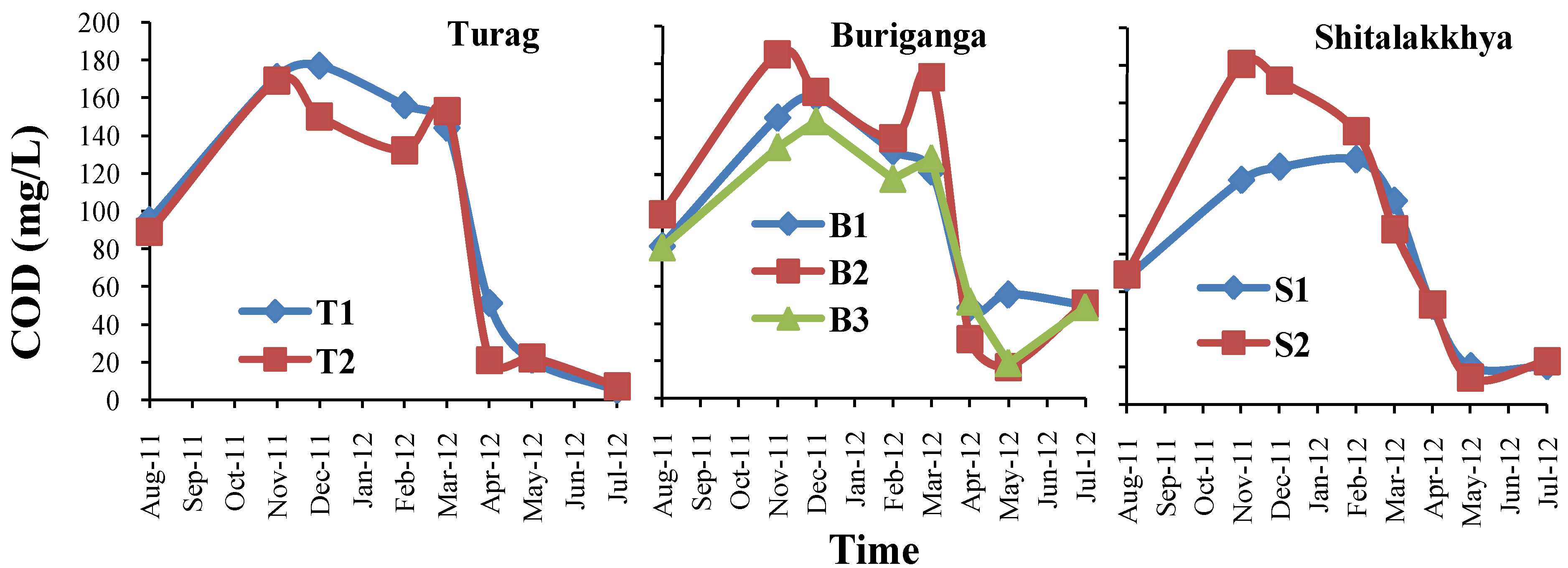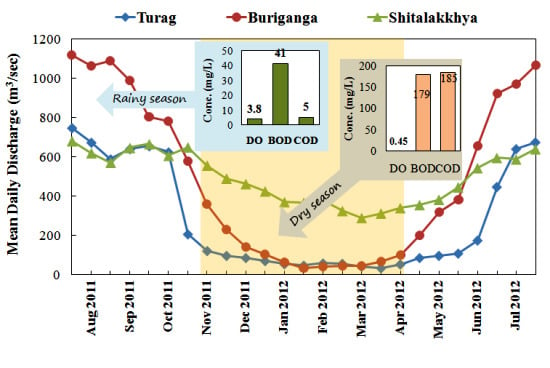Alteration of Water Pollution Level with the Seasonal Changes in Mean Daily Discharge in Three Main Rivers around Dhaka City, Bangladesh
Abstract
:1. Introduction

2. Materials and Methods
2.1. Study Area
2.2. Sample Collection and Preservation

2.3. General Water Quality Analyses
2.4. Determination of Metals
2.5. Statistical Analysis
3. Results and Discussion
3.1. Average Discharge of the Rivers around Dhaka City

3.2. Physicochemical Parameters
| DoE * Standard | Turag | Buriganga | Shitalakkhya | ||||
|---|---|---|---|---|---|---|---|
| Mean | Range | Mean | Range | Mean | Range | ||
| pH | 6–9 | 7.9 | 6.9–9.1 | 8.0 | 7.1–9.8 | 7.7 | 6.5–8.3 |
| EC (μS/cm) | 1200 | 1807 | 790–2850 | 1209 | 830–1990 | 1150 | 720–1920 |
| TDS (mg/L) | 2100 | 1003 | 650–1510 | 999 | 620–1260 | 820 | 475–1180 |
| DO (mg/L) | ≥4.5–8.0 | 1.2 | 0.45–3.2 | 1.7 | 0.45–3.5 | 2.1 | 0.6–3.8 |
| BOD (mg/L) | 50 | 110 | 56–179 | 93.7 | 41–151 | 86.7 | 44–146 |
| COD (mg/L) | 200 | 97.7 | 5–177 | 100 | 17–185 | 87 | 14–172 |






3.3. Concentrations of Metals
| Parameters(ppb) | DoE * Standard (ppb) | Turag | Buriganga | Shitalakkhya | |||
|---|---|---|---|---|---|---|---|
| Wet | Dry | Wet | Dry | Wet | Dry | ||
| Al | 200 | 92.65 | 294.38 | 79.62 | 152.27 | 113.24 | 116.61 |
| Mn | 5000 | 9.77 | 6.44 | 6.12 | 77.3 | 3.27 | 258.99 |
| Fe | 2000 | 12.67 | 380.75 | 9.82 | 358.68 | 11.19 | 341.21 |
| Cu | 500 | 2.52 | 7.39 | 4.13 | 6.75 | 1.97 | 15.83 |
| Zn | 5000 | 2.59 | ND | 2.49 | 23.12 | 1.89 | ND |
| Cd | 500 | 5.46 | ND | 5.47 | ND | 5.45 | ND |
| Pb | 100 | 4.75 | ND | 4.87 | ND | 4.72 | 1.86 |
4. Conclusions
Acknowledgments
Author Contributions
Conflicts of Interest
References
- Carpenter, S.R.; Caraco, N.F.; Correll, D.L.; Howarth, R.W.; Sharpley, A.N.; Smith, V.H. Nonpoint pollution of surface waters with phosphorus and nitrogen. Ecol. Appl. 1998, 8, 559–568. [Google Scholar] [CrossRef]
- Jarvie, H.P.; Whitton, B.A.; Neal, C. Nitrogen and phosphorus in east coast British rivers: Speciation, sources and biological significance. Sci. Total Environ. 1998, 210, 79–109. [Google Scholar] [CrossRef]
- Ahmed, K.; Das, M.; Islam, M.M.; Akter, M.S.; Islam, S.; Al-Mansur, M.A. Physico-chemical properties of tannery and textile effluents and surface water of River Buriganga and Karnatoli, Bangladesh. World Appl. Sci. J. 2011, 12, 152–159. [Google Scholar]
- Tiwari, T.N.; Ali, M. Water quality index for Indian rivers. In Ecology and Pollution of Indian Rivers; Trivedi, R.K., Ed.; Ashish publishing House: New Delhi, India, 1988; pp. 271–286. [Google Scholar]
- Islam, F.; Sharmin, R.; Junait, J. A Detailed Analysis on Industrial Pollution in Bangladesh; Workshop Discussion Paper; The World Bank Dhaka Office: Dhaka, Bangladesh, 1997. [Google Scholar]
- Mizan, R.K. Banglapedia: National Encyclopedia of Bangladesh; Asiatic Society of Bangladesh: Dhaka, Bangladesh, 2006. [Google Scholar]
- Roy, M. Planning for sustainable urbanization in fast growing cities: Mitigation and adaptation issues addressed in Dhaka, Bangladesh. Habitat Int. 2009, 33, 276–286. [Google Scholar] [CrossRef]
- Islam, M.M.; Akhtar, M.K.; Masud, M.S. Prediction of environmental flow to improve the water quality in the river Buriganga. In Proceedings of the 17th IASTED International Conference on Modeling and Simulation, Montreal, QC, Canada, 24–26 May 2006.
- Khan, M.A.I.; Hossain, A.M.; Huda, M.E.; Islam, M.S.; Elahi, S.F. Physico-chemical and biological aspects of monsoon waters of Ashulia for economic and aesthetic applications: Preliminary studies. Bangladesh J. Sci. Indus. Res. 2007, 42, 377–396. [Google Scholar]
- River Pollution Mitigation Committee (RPMC). Mitigation of River Pollution of Buriganga and Linked Rivers-Turag, Tongi Khal, Balu, Sitalakhya and Dhaleswari; A report of RPMC; River Pollution Mitigation Committee (RPMC): Dhaka, Bangladesh, 2008. [Google Scholar]
- The Daily Star. Polluters Must Pay, 19 September 2010. A News Report. Available online: http://archive.thedailystar.net/newDesign/news-details.php?nid=155050 (accessed on 12 May 2015).
- Blacksmith Institute. The World’s Worst Polluted Places: The Top Ten of the Dirty Thirty; Blacksmith Institute: New York, NY, USA, 2007; Available online: http://wwww.blacksmithinstitute.org/wwpp2007/finalReport2007.pdf (accessed on 10 February 2013).
- The Daily Star. River Pollution Discussion: A Wake up Call to Industrialists, 8 May 2009. A Round Table Discussion at the Daily Star. Available online: http://archive.thedailystar.net/newDesign/news-details.php?nid=87288 (accessed on 12 May 2015).
- DoE (Department of Environment). The Environment Conservation Rules; Ministry of Environment and Forest, Government of the People’s Republic of Bangladesh: Dhaka, Bangladesh, 1997.
- Bhuiyan, M.A.; Rakib, M.A.; Dampare, S.B.; Ganyaglo, S.; Suzuki, S. Surface water quality assessment in the central part of Bangladesh using multivariate analysis. KSCE J. Civ. Eng. 2011, 15, 995–1003. [Google Scholar] [CrossRef]
- Sikder, M.T.; Yasuda, M.; Yustiawati, S.S.; Saito, T.; Tanaka, S.; Kurasaki, M. Comparative Assessment of Water Quality in the Major Rivers of Dhaka and West Java. Int. J. Environ. Protec. 2012, 2, 8–13. [Google Scholar]
- Sikder, M.T.; Kihara, Y.; Yasuda, M.; Mihara, Y.; Tanaka, S.; Odgerel, D.; Mijiddorj, B.; Syawal, S.M.; Saito, T.; Kurasaki, M. River water pollution in developed and developing countries: Judge and assessment of physicochemical characteristics and selected dissolved metal concentration. CLEANSoil Air Water 2013, 41, 60–68. [Google Scholar] [CrossRef]
- Ali, M.Y.; Amin, M.N.; Alam, K. Ecological Health Risk of Buriganga River, Dhaka, Bangladesh. Hydro Nepal J. Water Energy Environ. 2008, 3, 25–28. [Google Scholar] [CrossRef]
- Moniruzzaman, M.; Elahi, S.F.; Jahangir, M.A.A. Study on Temporal Variation of Physico-chemical Parameters of Buriganga River Water through GIS (Geographical Information System) Technology. Bangladesh J. Sci. Ind. Res. 2009, 44, 327–334. [Google Scholar] [CrossRef]
- Alam, A.M.S.; Islam, M.A.; Rahman, M.A.; Siddique, M.N.; Matin, M.A. Comparative study of the toxic metals and non-metal status in the major river system of Bangladesh. Dhaka Univ. J. Sci. 2003, 51, 201–208. [Google Scholar]
- Ahmad, M.K.; Islam, S.; Rahman, S.; Haque, M.R.; Islam, M.M. Heavy Metals in Water, Sediment and Some Fishes of Buriganga River, Bangladesh. Int. J. Environ. Res. 2010, 4, 321–332. [Google Scholar]
- Uddin, H.M. Initial Environmental Impact Assessment of the Turag-Buriganga Naval Transport. Master Thesis, Department of Geography and Environment, Jahangirnagar University, Dhaka, Bangladesh, 10 July 2005. [Google Scholar]
- Talha, B.H. Pollution Sounds the Death Knell of Turag. The Independent. Available online: http://www.theindependent-bd.com/ (accessed on 28 September 2007).
- APHA-AWWA (American Public Health Association, American Water Works Association). Standard Methods for the Examination of Water and Wastewater, 20th ed.; American Public Health Association, American Water Works Association: Washington, DC, USA, 1998. [Google Scholar]
- Hanada, T.; Isobe, H.; Saito, T.; Ogura, S.; Takekawa, H.; Yamazaki, K.; Tokuchi, Y.; Kawakami, Y. Intracellular Accumulation of Thallium as a Marker of Cisplatin Cytotoxicity in Nonsmall Cell Lung Carcinoma. Cancer 1998, 83, 930–935. [Google Scholar] [CrossRef]
- Brady, N.C.; Well, R.R. The Nature and Properties of Soils, 12th ed.; Pearson Education, Inc.: New Delhi, India, 2002; pp. 261–269. [Google Scholar]
- Kabir, E.S.; Kabir, M.; Islam, S.M.; Mia, C.M.; Begum, N.; Chowdhury, D.A.; Sultana, S.M.; Rahman, S.M. Assessment of effluent quality of Dhaka export processing zone with special emphasis to the textile and dying industries. Jahangirnagar Univ. J. Sci. 2002, 25, 137–138. [Google Scholar]
- EGIS II (Environment and GIS Support Project for Water Sector Planning). Water Quality Approach: Draft Final Report; Ministry of Water Resources, Government of Bangladesh: Dhaka, Bangladesh, 2002.
- Sawyer, C.N.; McCarty, P.L.; Parkin, G.F. Chemistry for Environmental Engineering and Science, 5th ed.; McGraw-Hill: New York, NY, USA, 2003. [Google Scholar]
© 2015 by the authors; licensee MDPI, Basel, Switzerland. This article is an open access article distributed under the terms and conditions of the Creative Commons Attribution license (http://creativecommons.org/licenses/by/4.0/).
Share and Cite
Islam, M.S.; Uddin, M.K.; Tareq, S.M.; Shammi, M.; Kamal, A.K.I.; Sugano, T.; Kurasaki, M.; Saito, T.; Tanaka, S.; Kuramitz, H. Alteration of Water Pollution Level with the Seasonal Changes in Mean Daily Discharge in Three Main Rivers around Dhaka City, Bangladesh. Environments 2015, 2, 280-294. https://doi.org/10.3390/environments2030280
Islam MS, Uddin MK, Tareq SM, Shammi M, Kamal AKI, Sugano T, Kurasaki M, Saito T, Tanaka S, Kuramitz H. Alteration of Water Pollution Level with the Seasonal Changes in Mean Daily Discharge in Three Main Rivers around Dhaka City, Bangladesh. Environments. 2015; 2(3):280-294. https://doi.org/10.3390/environments2030280
Chicago/Turabian StyleIslam, Md. Saiful, M. Khabir Uddin, Shafi M. Tareq, Mashura Shammi, Abdul Kadir Ibne Kamal, Tomohiro Sugano, Masaaki Kurasaki, Takeshi Saito, Shunitz Tanaka, and Hideki Kuramitz. 2015. "Alteration of Water Pollution Level with the Seasonal Changes in Mean Daily Discharge in Three Main Rivers around Dhaka City, Bangladesh" Environments 2, no. 3: 280-294. https://doi.org/10.3390/environments2030280








